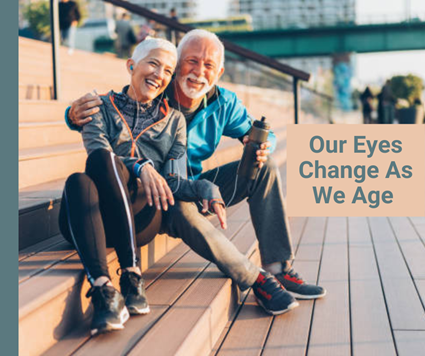Home » Blog » Age Related Vision Changes
Age Related Vision Changes
Posted by: Mitchell Refractive Surgery & Eye Center

As we age, we go through a few changes as adults, from our hair turning gray to changes in our eyesight. One of our priorities is making sure our patients are empowered with information to know what to expect to minimize eye health risks.
What Are The Common Age-Related Vision Changes?
- Increased sensitivity to glare – this can be an issue when driving.
- Difficulty reading and doing things close-up – this is called presbyopia, when the lenses become less flexible, making it hard to complete activities such as reading a menu.
- Brighter lighting is needed to see – As we age, we often need more light to see, work and read.
- Small changes in color perception – The eye lens can be slightly distorted and discolored, allowing muted colors. These changes may also be a sign of cataracts, a clouding of the eye. According to the Mayo Clinic, about half of all 65-year-old Americans have some degree of cataract formation in their eyes.
What Are Some Major Age-Related Eye Diseases?
- Macular Degeneration (AMD) – More than two million Americans currently have age-related macular degeneration, which is expected to double by 2050 due to the aging population.
- Glaucoma – The risk of glaucoma increases each decade after the age of 40 from 1 percent to 12 percent in your 80s.
Listed below are a few symptoms that could be the early warning signs of a serious eye health problem as we age.
- Seeing distorted images – Straight lines that appear distorted or wavy or an empty area in the center of your vision could be signs of age-related macular degeneration (AMD). The disease affects the macula, which is the part of your retina that is responsible for central vision. The condition causes a blind spot in the middle of your field of vision.
- Fluctuating vision – Frequent changes in how clearly you can see maybe a sign of diabetes or hypertension (high blood pressure). These chronic conditions can damage the tiny blood vessels in the retina, the light-sensitive layer at the back of the eye. This vision loss can sometimes be permanent.
- Seeing floaters and flashes – Seeing spots or floaters in your eyes of shadowy images of particles floating in the fluid that fills the inside of the eye. Although they can be bothersome, spots and floaters typically don’t harm vision and is a natural part of the eye’s aging process. If you suddenly see more floaters than usual, along with bright, flashing lights, schedule an appointment with your eye doctor immediately to prevent.
- Loss of side vision – Losing peripheral or side vision may be a sign of glaucoma. Glaucoma occurs when the optic nerve is damaged and no longer transmits all visual images to the brain. It often has no symptoms until damage to your vision has begun.
Regular eye examinations, early diagnosis, and treatment of eye diseases can help you preserve good eye health throughout your life. Many eye conditions can have the option of treatment or are delayed with early detection; annual eye exams can assist in proactive detection.
How To Promote Healthy Vision?
One significant component of promoting positive eye health is to live a healthy lifestyle. Eat healthily, stay active, and don’t smoke. Keep in mind to protect your eyes from the UV rays by wearing UV-blocking sunglasses when outdoors on a sunny or cloudy day. Also, take breaks from the computer screen, especially if you spend most of your work hours at a computer screen, resulting in digital eye strain. Remember to follow the 20-20-20 rule: every 20 minutes, focus on an object at least 20 feet away for 20 seconds. Your eyes will love you for it!
Your Healthy Eyes Is Our Priority!
If it has been a while since we have seen you, call us TODAY to schedule an appointment to make your eye health a priority.
References: American Academy of Ophthalmology and American Optometric Association
The content is researched and vetted by the American Academy of Ophthalmology and the American Optometric Association. This blog provides information and discussion about eye health and related subjects. The content provided on this blog and any linked materials are not intended and should not be considered medical advice. If the reader or any person has a medical concern, they should consult with an appropriately licensed physician.
